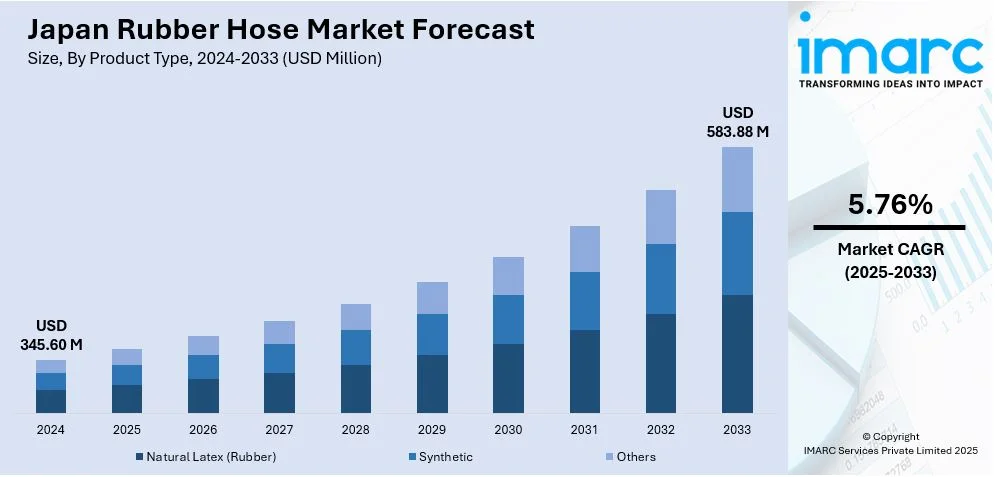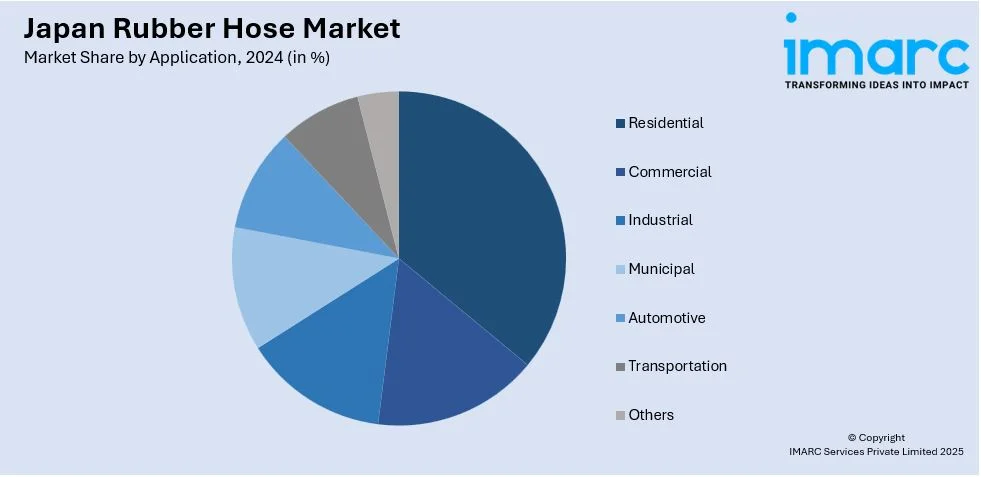
Japan Rubber Hose Market Size, Share, Trends and Forecast by Product Type, Media, Pressure Rating, Application, and Region, 2025-2033
Japan Rubber Hose Market Overview:
The Japan rubber hose market size reached USD 345.60 Million in 2024. Looking forward, IMARC Group expects the market to reach USD 583.88 Million by 2033, exhibiting a growth rate (CAGR) of 5.76% during 2025-2033. The market is influenced by various factors, including technological advancements in manufacturing processes, the increased demand for high-performance hoses by industries, and the increased concern for sustainability. Additionally, the expansion of infrastructure developments and the automobile sector significantly influences market growth.
|
Report Attribute
|
Key Statistics
|
|---|---|
|
Base Year
|
2024 |
|
Forecast Years
|
2025-2033
|
|
Historical Years
|
2019-2024
|
| Market Size in 2024 | USD 345.60 Million |
| Market Forecast in 2033 | USD 583.88 Million |
| Market Growth Rate 2025-2033 | 5.76% |
Japan Rubber Hose Market Trends:
Technological Advancements in Manufacturing
The Japanese rubber hose market is seeing rapid technological progress in the form of improved product performance and production efficiency. The industry is spending on automation and precision engineering to make hoses that are more durable and resistant to harsh conditions. These technologies serve the changing requirements of industries like automotive, construction, and agriculture, where performance and reliability take precedence. In addition, the embedding of smart technologies like sensors and monitoring systems within rubber hoses is emerging as a growing trend. Such smart hoses support real-time performance monitoring and predictive maintenance, thus lowering downtime and increasing service life. The ongoing emphasis on R&D ensures that Japanese manufacturers lead the rubber hose market globally. For instance, in February 2025, Yokohama Rubber Co., Ltd. developed the world’s first theoretical model predicting rubber wear on multiscale rough surfaces. The model accurately forecasts wear rates and particle distribution under various conditions. This breakthrough supports tire design innovation for enhanced wear resistance, crucial for EVs. It aligns with Yokohama’s plan focused on sustainability, AI-driven development, and rapid, cost-effective production improvements.

Emphasis on Sustainability and Eco-friendly Materials
Sustainability has become a critical focus in the Japanese rubber hose market, driven by both regulatory pressures and consumer demand for environmentally friendly products. Manufacturers are increasingly adopting bio-based and recyclable materials in the production of rubber hoses. This shift not only aligns with global environmental standards but also caters to the growing preference for sustainable products among consumers and businesses. Additionally, companies are exploring innovative manufacturing processes that reduce carbon footprints and minimize waste. The adoption of eco-friendly practices is not only beneficial for the environment but also enhances the marketability of products, giving companies a competitive edge in the marketplace. For instance, in June 2023, Toyoda Gosei Co., Ltd. and Toyota Central R&D Labs announced the joint development of an energy-saving technology that significantly reduces steam usage in rubber product manufacturing. By optimizing air-steam exchange in autoclaves through advanced simulation, the new system halves steam consumption during discharge. Already in use at Toyoda Gosei’s Morimachi Plant, the technology is expected to cut 110 tons of CO₂ annually. Plans are in place to expand its adoption globally, supporting carbon neutrality goals by 2050.
Japan Rubber Hose Market Segmentation:
IMARC Group provides an analysis of the key trends in each segment of the market, along with forecasts at the country/regional levels for 2025-2033. Our report has categorized the market based on product type, media, pressure rating, and application.
Product Type Insights:
- Natural Latex (Rubber)
- Synthetic
- Others
The report has provided a detailed breakup and analysis of the market based on the product type. This includes natural latex (rubber), synthetic, and others.
Media Insights:
- Water
- Oil
- Hot Water and Steam
- Air/Gas
- Food and Beverage
- Chemical
A detailed breakup and analysis of the market based on the media have also been provided in the report. This includes water, oil, hot water and steam, air/gas, food and beverage, and chemical.
Pressure Rating Insights:
- Low
- Medium
- High
A detailed breakup and analysis of the market based on the pressure rating have also been provided in the report. This includes low, medium, and high.
Application Insights:

- Residential
- Commercial
- Industrial
- Municipal
- Automotive
- Transportation
- Others
A detailed breakup and analysis of the market based on the application have also been provided in the report. This includes residential, commercial, industrial, municipal, automotive, transportation, and others.
Regional Insights:
- Kanto Region
- Kansai/Kinki Region
- Central/ Chubu Region
- Kyushu-Okinawa Region
- Tohoku Region
- Chugoku Region
- Hokkaido Region
- Shikoku Region
The report has also provided a comprehensive analysis of all the major regional markets, which include Kanto, Kansai/Kinki, Central/ Chubu, Kyushu-Okinawa, Tohoku, Chugoku, Hokkaido, and Shikoku Region.
Competitive Landscape:
The market research report has also provided a comprehensive analysis of the competitive landscape. Competitive analysis such as market structure, key player positioning, top winning strategies, competitive dashboard, and company evaluation quadrant has been covered in the report. Also, detailed profiles of all major companies have been provided.
Japan Rubber Hose Market News:
- In April 2025, Sumitomo Rubber Industries announced the full-scale launch of its Yamanashi Model P2G System at the Shirakawa Plant in Fukushima Prefecture. This hydrogen production system, powered by renewable energy, marks a significant step in the company’s sustainability strategy. The new system allows on-site hydrogen production, complementing existing hydrogen usage methods. The initiative supports the company's broader commitment to environmentally friendly manufacturing and represents a key innovation in sustainable energy utilization within the tire and rubber industry.
- In March 2025, Yokohama Rubber Co., Ltd. announced it is supplying its GEOLANDAR X-CV and GEOLANDAR A/T G015 tires as original equipment for the all-new Nissan Armada SUVs launched in North America. The X-CV offers high-speed performance and quiet driving for SL and Platinum models, while the A/T G015 enhances off-road durability for the PRO-4X variant. This move aligns with Yokohama’s YX2026 strategy to boost sales of high-value-added tires, particularly through its flagship GEOLANDAR and ADVAN brands.
Japan Rubber Hose Market Report Coverage:
| Report Features | Details |
|---|---|
| Base Year of the Analysis | 2024 |
| Historical Period | 2019-2024 |
| Forecast Period | 2025-2033 |
| Units | Million USD |
| Scope of the Report |
Exploration of Historical Trends and Market Outlook, Industry Catalysts and Challenges, Segment-Wise Historical and Future Market Assessment:
|
| Product Types Covered | Natural Latex (Rubber), Synthetic, Others |
| Medias Covered | Water, Oil, Hot Water and Steam, Air/Gas, Food and Beverage, Chemical |
| Pressure Ratings Covered | Low, Medium, High |
| Applications Covered | Residential, Commercial, Industrial, Municipal, Automotive, Transportation, Others |
| Regions Covered | Kanto Region, Kansai/Kinki Region, Central/Chubu Region, Kyushu-Okinawa Region, Tohoku Region, Chugoku Region, Hokkaido Region, Shikoku Region |
| Customization Scope | 10% Free Customization |
| Post-Sale Analyst Support | 10-12 Weeks |
| Delivery Format | PDF and Excel through Email (We can also provide the editable version of the report in PPT/Word format on special request) |
Key Questions Answered in This Report:
- How has the Japan rubber hose market performed so far and how will it perform in the coming years?
- What is the breakup of the Japan rubber hose market on the basis of product type?
- What is the breakup of the Japan rubber hose market on the basis of media?
- What is the breakup of the Japan rubber hose market on the basis of pressure rating?
- What is the breakup of the Japan rubber hose market on the basis of application?
- What is the breakup of the Japan rubber hose market on the basis of region?
- What are the various stages in the value chain of the Japan rubber hose market?
- What are the key driving factors and challenges in the Japan rubber hose market?
- What is the structure of the Japan rubber hose market and who are the key players?
- What is the degree of competition in the Japan rubber hose market?
Key Benefits for Stakeholders:
- IMARC’s industry report offers a comprehensive quantitative analysis of various market segments, historical and current market trends, market forecasts, and dynamics of the Japan rubber hose market from 2019-2033.
- The research report provides the latest information on the market drivers, challenges, and opportunities in the Japan rubber hose market.
- Porter's five forces analysis assist stakeholders in assessing the impact of new entrants, competitive rivalry, supplier power, buyer power, and the threat of substitution. It helps stakeholders to analyze the level of competition within the Japan rubber hose industry and its attractiveness.
- Competitive landscape allows stakeholders to understand their competitive environment and provides an insight into the current positions of key players in the market.
Need more help?
- Speak to our experienced analysts for insights on the current market scenarios.
- Include additional segments and countries to customize the report as per your requirement.
- Gain an unparalleled competitive advantage in your domain by understanding how to utilize the report and positively impacting your operations and revenue.
- For further assistance, please connect with our analysts.
 Request Customization
Request Customization
 Speak to an Analyst
Speak to an Analyst
 Request Brochure
Request Brochure
 Inquire Before Buying
Inquire Before Buying




.webp)




.webp)












